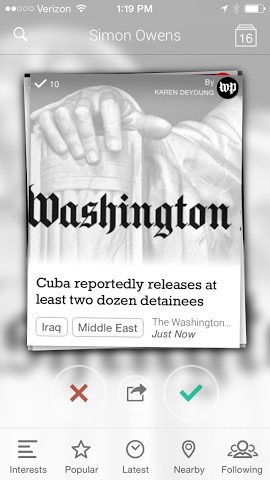 In many ways, Alex Skatell seems like the last person in the world who would be developing a news product that could be described as anti-clickbait. After all, Skatell launched the Independent Journal Review (IJReview for short), an Upworthy-style viral aggregation site that now receives over 30 million unique visitors a month and ranks within the top 50 most-visited websites in the U.S. Then, about a year ago, the company he now co-owns debuted Liftbump, a site aggregating uplifting stories, images, and videos; in the past six months the site has grown quickly to reach 10 million monthly unique visitors. It seems clear that he and his colleagues have figured out whatever insight allows them to tap into the human compulsion to click on and propagate content; the result is his sites’ hyperbolic headlines ricocheting across your Facebook News Feed, each link more enticing than the last.
In many ways, Alex Skatell seems like the last person in the world who would be developing a news product that could be described as anti-clickbait. After all, Skatell launched the Independent Journal Review (IJReview for short), an Upworthy-style viral aggregation site that now receives over 30 million unique visitors a month and ranks within the top 50 most-visited websites in the U.S. Then, about a year ago, the company he now co-owns debuted Liftbump, a site aggregating uplifting stories, images, and videos; in the past six months the site has grown quickly to reach 10 million monthly unique visitors. It seems clear that he and his colleagues have figured out whatever insight allows them to tap into the human compulsion to click on and propagate content; the result is his sites’ hyperbolic headlines ricocheting across your Facebook News Feed, each link more enticing than the last.
![]() Yet when I spoke to him about Shuffle, the mobile news app his company launched last month, Skatell told me that many of the stories featured on the app would be the kind you’re least likely to share on Facebook. “I may read a thousand stories a week, but only share one or two of them,” he said. “That’s not necessarily the best information for me to see, but it’s what shows up on social media sites. So how do you surface the other thousand articles that are being read, but nobody is really posting to social media?”
Yet when I spoke to him about Shuffle, the mobile news app his company launched last month, Skatell told me that many of the stories featured on the app would be the kind you’re least likely to share on Facebook. “I may read a thousand stories a week, but only share one or two of them,” he said. “That’s not necessarily the best information for me to see, but it’s what shows up on social media sites. So how do you surface the other thousand articles that are being read, but nobody is really posting to social media?”
The launch of the app comes as his company, Media Group of America, continues to shift from a ragtag group of content aggregators to a more mature media entity. Skatell launched IJReview in 2012 as a side project while he was working a fulltime job as digital director for the National Republican Senatorial Committee. He hired a friend to edit the site and manage a small group of freelancers, and it wasn’t long before it began to generate serious traffic. It was around this time when Facebook began altering its algorithm to direct more of its readers toward news content, and those content producers who learned to capitalize on this shift were able to launch traffic-generating behemoths seemingly overnight. Suddenly you began to see news stories expressing wonderment that previously-unknown entities like Upworthy and ViralNova were collecting more social media shares than The New York Times.
This development was met with no small amount of consternation from those who worry that Facebook is incentivizing the wrong kind of reading behavior. A recent New Yorker profile of a clickbait connoisseur — who has attracted millions of dollars in venture capital for his websites that do little more than repurpose listicles — resulted in harsh criticism against an industry propped up by the empty calories of pageviews.
After the election cycle ended in 2012, Skatell was making enough income from the site to focus full-time on IJReview, and in the process teamed up with Phil Musser, a longtime Republican media consultant, as his partner. The two launched Media Group of America, which in addition to publishing IJReview and Liftbump also runs a digital marketing consultancy for brands and politicians. And with the launch of Shuffle, it now has a technology arm, one that hopes to develop news products that utilize machine learning to predict what news you want and need to consume.
To understand the philosophy of Shuffle’s approach to news and how it determines what you should read, you have to first think about why sites like IJReview have been so successful. A slate of recent studies into the social media habits of Americans have found that what we share doesn’t necessarily reflect our reading habits, but rather what we want others to believe are our reading habits. More specifically, we share news as a way to promote our outward facing selves and the passions and beliefs that we want others to know we hold.
The Pew Research Center has conducted several surveys trying to unravel our motivations for sharing social media content, and in August it released a study finding that “in both personal settings and online settings, people were more willing to share their views if they thought their audience agreed with them.” A survey commissioned by Ogilvy found that 36 percent of respondents said they mostly share content that promotes a cause or belief, and many of those surveyed said sharing on social media “helps define their personality.” Another Pew study reported that the vast majority of Facebook links are shared by a small minority of users, and most people either passively consume content or comment on other friends’ status updates.
This is why these viral aggregators traffic in hyperbole: It helps engender an impassioned response from the reader. “I think with Twitter and Facebook, the types of content that people share is the content that’s a 9 or 10 on the passion scale,” said Skatell. “It serves as ammunition for their beliefs. But that’s not necessarily the most important content they should be sharing. It’s not what everyone in their town is sort of thinking or talking about or reading.” So as his company began contemplating how a potential mobile news app could work, he and his colleagues quickly realized that it would need to utilize both passive and active feedback when prioritizing content.
When Carl Sceusa, who leads the product team for Shuffle, began to try out other mobile news apps, he found that each left something to be desired when it came to recommending headlines. “None of them seemed to really fulfill our needs,” he said. “Specifically in that there’s so much content out there nowadays — sorting through it is just a massive undertaking. We couldn’t really get to the things that were most relevant to you.”
The world of news aggregation apps is becoming an increasingly crowded space. I profiled several of these apps in a recent article detailing how publishers are flocking to them while also abandoning their own standalone apps. Flipboard stands as the most popular, with over 100 million users, but others have secured respectable adoption from millions of news consumers. In many cases, the apps I profiled allow you to choose categories and subtopics that interest you and then serve up those topics when you open the app. But Sceusa finds this method of news sorting rudimentary. “Most the apps out there use just manual setup and kind of leave it at that,” he said. “It’s not refining what it’s showing you based on every single action you take. People might not know necessarily the specific types of news they’re actually reading as opposed to what they think they’d like to see.”
 To understand what he meant, I downloaded the Shuffle app on my phone, and after sifting through several options and choosing which topics interest me, it began serving me content. The first thing that struck me was that it only offers up one headline to me at a time, forcing me to make a tacit disapproval or approval of the content based on whether I click on the headline to read more or swipe it away. In addition to swiping away content, you can also give more explicit feedback in the form of clicking on a red X or a green checkmark.
To understand what he meant, I downloaded the Shuffle app on my phone, and after sifting through several options and choosing which topics interest me, it began serving me content. The first thing that struck me was that it only offers up one headline to me at a time, forcing me to make a tacit disapproval or approval of the content based on whether I click on the headline to read more or swipe it away. In addition to swiping away content, you can also give more explicit feedback in the form of clicking on a red X or a green checkmark.
The app also allows you to change your filters so you can choose between your interests, what’s most popular, and what’s “nearby.” The nearby function, Skatell told me, is one of the app’s most important features, in that it uses geotagging to show you what other people nearby are reading. This will expose you to not only the national stories that your geographic area finds relevant — for instance, if you live in D.C., you’re likely to see a lot of political and policy headlines — but can also surface important local reports as well. “Local news outlets have a really tough time competing now with national news on Facebook, because the kinds of things they’re reporting on aren’t necessarily the kinds of things that are shared on Facebook and Twitter.”
So how did my own reading experience shape up as I tried it out over a period of days? Well, despite giving Shuffle no direct feedback to indicate I’m interested in sports, a sizable portion of the headlines served up to me were sports-related. I also was once again reminded why I love Twitter so much — the content Twitter shows me is based on a list of users, many with similar interests to mine, that I’ve spent curating over a period of years. The challenge every news app faces when trying to win me over is quickly surmounting the steep learning curve that allows it to predict my own quirky news interests. It could get tiresome swatting away headlines one at a time just so I could arrive at an article that I might want to click on and read in full. That stickiness that compels me to open up my Facebook and Twitter apps when I’m sitting at a lunch counter by myself or waiting in line didn’t seem to set in while I was trying out Shuffle.
But then again, its algorithm is still in its early learning phase, and trying the app out months from now, when it’s had the chance to harness millions of interactions from new users, may yield more compelling options for news consumption. When I spoke to Skatell, he said his company had only secured partnerships with about 50 news producers, so it’s easy to imagine a more robust selection once it’s secured more participation. (And with the announcement last week of major angel funding, it’ll have the resources to compete with bigger players.)
This story originally appeared on SimonOwens.net.